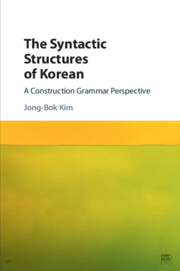Book contents
- Frontmatter
- Contents
- Acknowledgments
- Abbreviations
- 1 Theoretical foundations
- 2 Noun phrases
- 3 Case system
- 4 Auxiliary and complex predicate constructions
- 5 Gerund phrases and mixed categories
- 6 Verbal nouns and light verb constructions
- 7 Serial verb constructions
- 8 Negation and related phenomena
- 9 Coordination
- 10 Passive constructions
- 11 Wh-questions
- 12 Topic and focus constructions
- 13 Relative clause constructions
- 14 Honorification
- References
- Index
5 - Gerund phrases and mixed categories
Published online by Cambridge University Press: 05 July 2016
- Frontmatter
- Contents
- Acknowledgments
- Abbreviations
- 1 Theoretical foundations
- 2 Noun phrases
- 3 Case system
- 4 Auxiliary and complex predicate constructions
- 5 Gerund phrases and mixed categories
- 6 Verbal nouns and light verb constructions
- 7 Serial verb constructions
- 8 Negation and related phenomena
- 9 Coordination
- 10 Passive constructions
- 11 Wh-questions
- 12 Topic and focus constructions
- 13 Relative clause constructions
- 14 Honorification
- References
- Index
Summary
One of the main puzzles in the Korean verbal gerund phrases is that they display a mix of nominal and verbal properties. This has provided a challenge to syntactic analyses with a strict version of X-bar theory. Various approaches have been proposed to solve this puzzle, but most have ended up abandoning or modifying fundamental theoretical conditions such as endocentricity, lexicalism, and null licensing. This chapter shows that the multiple inheritance system employed within a construction-based grammar can offer us a clean analysis of the mixed properties we find in Korean gerund constructions.
Verbal and nominal properties
Like English gerund phrases (GPs), Korean GPs also internally exhibit verbal properties and externally display nominal properties (see, among others, Chung et al. 2001, Kim and Yang 2005). Internal verbal properties are prevalent. One telling piece of evidence comes from the inheritance of arguments from the lexemic verb from which the gerund is derived. As shown in (1), the gerund is not different from the tensed verb of the embedded clause in selecting arguments:
(1) a. [Kim-i ecey ku chayk-ul/*uy ilk-ess-ta]-ko
Kim-NOM yesterday that book-ACC/*GEN read-PST-DECL-COMP
sayngkakha-n-ta
think-PRES-DECL
‘(I) think Kim read the book yesterday.’
b. [Kim-i ecey ku chayk-ul/*uy ilk-ess-um]-i
Kim-NOM yesterday that book-ACC/*GEN read-PST-NMLZ-NOM
myenghwakha-ta
clear-DECL
‘Kim's having read the book yesterday is clear.’
Various other phenomena also show that GPs are internally similar to VPs. Consider the following:
(2) a. Kim-i ku chayk-ul pwunmyenghi ilk-ess-um
Kim-NOM that book-ACC evidently read-PST-NMLZ
‘Kim's having evidently read the book.’
b. Kim-i chayk-ul ppalli/*ppalun ilk-um
Kim-NOM book-ACC fast(adv)/*fast(adj) read-NMLZ
‘Kim's reading books fast.’
c. Kim-i chayk-ul an ilk-um
Kim-NOM book-ACC not read-NMLZ
‘Kim's not reading books.’
As illustrated in (2a), the GP construction can include a sentential adverb; it can be modified by a VP adverb as in (2b), or can be negated by the sentential negator an as in (2c).
In addition, an auxiliary verb can be realized as a gerund verb form, as shown in (3a). The sentence with a gerund also allows free scrambling. The example in (3b) illustrates that the object of a gerund, just like that of a finite verb, can equally be scrambled to the sentence-initial position.
- Type
- Chapter
- Information
- The Syntactic Structures of KoreanA Construction Grammar Perspective, pp. 104 - 120Publisher: Cambridge University PressPrint publication year: 2016



